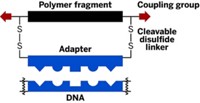Advertisement
Grab your lab coat. Let's get started
Welcome!
Welcome!
Create an account below to get 6 C&EN articles per month, receive newsletters and more - all free.
It seems this is your first time logging in online. Please enter the following information to continue.
As an ACS member you automatically get access to this site. All we need is few more details to create your reading experience.
Not you? Sign in with a different account.
Not you? Sign in with a different account.
ERROR 1
ERROR 1
ERROR 2
ERROR 2
ERROR 2
ERROR 2
ERROR 2
Password and Confirm password must match.
If you have an ACS member number, please enter it here so we can link this account to your membership. (optional)
ERROR 2
ACS values your privacy. By submitting your information, you are gaining access to C&EN and subscribing to our weekly newsletter. We use the information you provide to make your reading experience better, and we will never sell your data to third party members.
Synthesis
Double Duty For DNA-Binding Molecules
February 12, 2007
| A version of this story appeared in
Volume 85, Issue 7
A new class of DNA-binding molecules that can accomplish sequence-specific binding and fluorescent reporting within one molecular platform has been created by David M. Chenoweth, Anne Viger, and Peter B. Dervan of California Institute of Technology (J. Am. Chem. Soc., DOI: 10.1021/ja0682576). These oligomers "announce" their association with double-stranded DNA by means of a fluorescent moiety incorporated within the binding module. Previously, when researchers wanted to locate and visualize a specific DNA sequence, they had two options: make a DNA-binding molecule tagged to a separate bulky fluorescent reporter, or use a DNA-binding molecule that requires harsh denaturation conditions in order to hybridize to DNA. The new compounds modify Dervan's well-established DNA-binding polyamides to introduce a series of heterocyclic rings that provide the fluorescent kick. The oligomers can be applied as "chromosome paints" to identify desired DNA sequences, Chenoweth says. So far, the fluorescent tags bind best to sections of DNA containing guanine (G), such as TACG or GGGG sequences, but an expansion of the target base-pair lexicon is in the works.




Join the conversation
Contact the reporter
Submit a Letter to the Editor for publication
Engage with us on Twitter